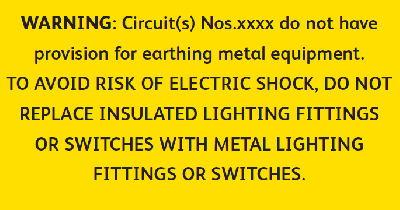Lighting Circuits Without an Earth
Background
Many lighting circuits (usually installed pre 1966) are still in use that have no earthing. What is popularly called the earth wire, the wiring regulations call the Circuit Protective Conductor or CPC.
Rewiring these circuits is the preferable solution, but for some people the cost of installation and redecorating can be prohibitive.
Spotting them
The ways these historic cicuits are spotted are:
- When changing a fitting, only 2 core cable is fitted
- Historic round bakelite switches
Safety
Metal light fittings or switches on an unearthed circuit are a shock risk. If insulation fails, and that's not a rarity, the fitting will often become live. Touching that is a risk to life. One cause of insulation failure is buildup of dirt at connection points, something that happens over the years.
Since unearthed lighting circuits are generally around half a century old, they fall short on other safety features expected in a modern installation, some of which are very basic and necessary. Common problems include:
1. Badly perished rubber insulation.
2. Light switches that can sit in mid position, and if luck deserts you, sit in an almost on position and arc. This either burns the switch out or causes a fire.
3. Non-EEBAD installation. Such installations can fail to blow a fuse when necessary, occasionally resulting in risk to life.
4. Dirt buildup at connection points. This can cause insulation breakdown, a fire & shock risk.
5. Poor connections. Connections can deteriorate due to decades of thermal cycling, wire corrosion, or less than ideal design & construction of historic fittings.
6. Flammable wiring enclosures, such as wooden pattresses behind light switches.
7. Light switch covers that undo easily by hand, a danger primarily to children.
Reducing risk
If a rewire is not an option then the following steps should be taken for safety reasons:
- Metal (Class I insulated) light fittings and metal accessories should be replaced with (Class II) fittings, which are either plastic, or metal and marked with the
 Class II symbol.
Class II symbol. - Insulation Resistance Test. The circuit should be tested between the line conductor (live and neutral connected together) and the earth terminal of the consumer unit. The resistance should be at least 1 Megohm. If the resistance is less that 1 Megohm the circuit must have additional RCD protection. The test should also be repeated between the live & neutral conductors and any exposed conductive part of the circuit (eg the screws for a lightswitch with a metal backbox). Again if the readings are less than 1 Megohm then additional RCD protection is necessary.
- RCD protection. It is advisable to have 30mA RCD protection on lighting circuits that have no cpc, and essential if the resistance readings are lower than 1 Megohm.
- Any 2A or 5A sockets connected to the lighting circuit that may be used for portable equipment should be disconnected. Dedicated clock connectors can be left in place.
- A warning notice similar to the one below should be fixed on or adjacent to the CU or fusebox:
- Metal (Class I insulated) light fittings and metal accessories should be replaced with (Class II) fittings, which are either plastic, or metal and marked with the
Potential problems
Extending the circuit
Not having an earth wire on a lighting circuit makes it impossible to extend the circuit for extra lighting points in a way that meets current wiring regulations. Extension can in principle be done safely if all switches, pattresses and lights are plastic, and remain plastic, but
- regulations have demanded an earthed lighting circuit since 1966
- possible later replacement with metal fittings can make them unsafe
One viable workaround to add lighting points, is to feed them via another circuit that does have an earth wire. This can be another more recent lighting circuit, or can be a socket circuit via a fused connection unit (with 5A or 3A fuse).
Consumer unit upgrades
Many electricians may also refuse to swap a fusebox for a CU unless the old lighting circuit is also rewired.
Unsuitable wire
Most 2 core circuits are wired with historic flex that can handle the current of the lighting circuit. But there are also circuits wired up using entirely unsuitable wire in use, such as bell wire and speaker wire. These are a significant fire risk, and indicate seriously substandard work. If such wire is found it really needs rewiring.
Some people refuse to rewire in such situations. In this case at least switching from filament lamps to CFL can reduce the risk considerably, due to their much lower power consumption. But if the wiring's that bad, who knows what else is lurking.
